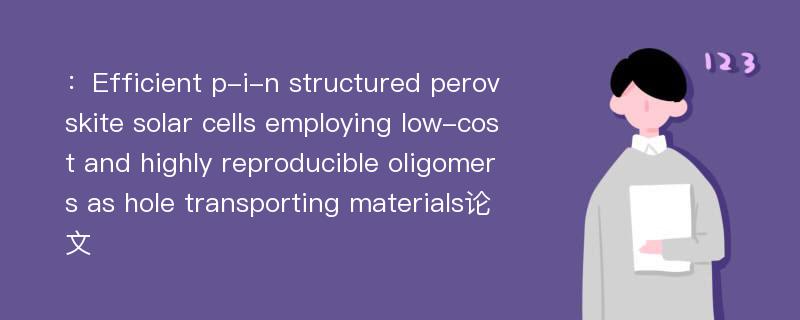
本文主要研究内容
作者(2019)在《Efficient p-i-n structured perovskite solar cells employing low-cost and highly reproducible oligomers as hole transporting materials》一文中研究指出:The development of p-i-n structured perovskite solar cells(PSCs) requires more extensive explorations on seeking efficient, low cost and stable hole transporting materials(HTMs). Small molecular HTMs are superior to polymeric ones in terms of synthetic reproducibility as well as purity. However, thin films composed of small molecules are usually labile during the solution-based perovskite deposition. Herein, we propose a molecular engineering strategy of incorporating oligothiophene as conjugation bridge to develop robust oligomer HTMs for p-i-n type PSCs. Upon increasing the oligothiophene chain length from α-bithiophene to α-quaterthiophene and α-hexathiophene, their HOMO energy levels remain unchanged, but their solubility in common organic solvents decreased remarkably, thus greatly enhancing their tolerance to the perovskite deposition. The rational design of oligothiophene chain length can effectively tune their optoelectronic properties as well as thin film stability under polar solvent soaking. The best performance is achieved by an α-quaterthiophene based HTM(QT), showing a high efficiency of 17.69% with fill factor of 0.81, which are comparable to those of a commercially available benchmark polymer HTM(poly[bis(4-phenyl)(2,4-dimethylphenyl) amine], PTAA) based devices fabricated under the same conditions. Our developed oligomer system not only provides the definite molecular structures like small molecule-type HTMs, but also exhibits the excellent filmforming like polymer-type HTMs, thus achieving the well-balanced parameters among solvent tolerance, thin film conductivity,and interfacial charge transfer efficiency, especially building up a platform to develop low cost and reproducible efficient HTMs in p-i-n structured perovskite solar cells.
Abstract
The development of p-i-n structured perovskite solar cells(PSCs) requires more extensive explorations on seeking efficient, low cost and stable hole transporting materials(HTMs). Small molecular HTMs are superior to polymeric ones in terms of synthetic reproducibility as well as purity. However, thin films composed of small molecules are usually labile during the solution-based perovskite deposition. Herein, we propose a molecular engineering strategy of incorporating oligothiophene as conjugation bridge to develop robust oligomer HTMs for p-i-n type PSCs. Upon increasing the oligothiophene chain length from α-bithiophene to α-quaterthiophene and α-hexathiophene, their HOMO energy levels remain unchanged, but their solubility in common organic solvents decreased remarkably, thus greatly enhancing their tolerance to the perovskite deposition. The rational design of oligothiophene chain length can effectively tune their optoelectronic properties as well as thin film stability under polar solvent soaking. The best performance is achieved by an α-quaterthiophene based HTM(QT), showing a high efficiency of 17.69% with fill factor of 0.81, which are comparable to those of a commercially available benchmark polymer HTM(poly[bis(4-phenyl)(2,4-dimethylphenyl) amine], PTAA) based devices fabricated under the same conditions. Our developed oligomer system not only provides the definite molecular structures like small molecule-type HTMs, but also exhibits the excellent filmforming like polymer-type HTMs, thus achieving the well-balanced parameters among solvent tolerance, thin film conductivity,and interfacial charge transfer efficiency, especially building up a platform to develop low cost and reproducible efficient HTMs in p-i-n structured perovskite solar cells.
论文参考文献
论文详细介绍
论文作者分别是来自Science China(Chemistry)的,发表于刊物Science China(Chemistry)2019年06期论文,是一篇关于,Science China(Chemistry)2019年06期论文的文章。本文可供学术参考使用,各位学者可以免费参考阅读下载,文章观点不代表本站观点,资料来自Science China(Chemistry)2019年06期论文网站,若本站收录的文献无意侵犯了您的著作版权,请联系我们删除。
